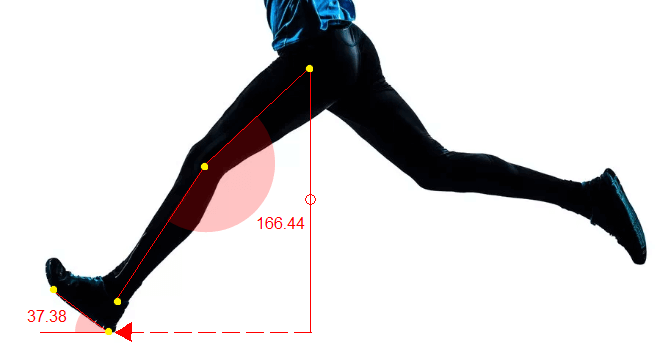To understand the correlation between running biomechanics and Proximal Hamstring tendinopathy, its important to consider the cause of compression on the proximal hamstring tendon against the ischial tuberosity.
You guessed it, hip flexion. The greater the hip flexion angle, the greater the compression of the underlying hamstring tendon against the ischial tuberosity as it curves around the inferior portion. This is likely one of the primary reasons patients complain about sitting and deep squatting.
BIOMECHANICAL FAULTS THAT LEAD TO PROXIMAL HAMSTRING TENDINOPATHY
OVERSTRIDING
The moment of foot strike (initial contact) in a gait cycle is commonly associated with maximum hip flexion. Now, imagine a case of an amateur runner looking to increase his running performance through an increase in stride length. Such amateur runners tend to achieve this goal through excessive hip flexion & increased knee extension at foot strike.
From a performance point of view, this might be good as it is gives that extra distance to increase the stride length. However, this puts excessive stress on the hamstring, leading to PHT.

EXCESSIVE FORWARD TRUNK LEAN

A small degree of forward trunk lean may place the lower spine in a more neutral position and reduced the tendency of overstriding. However, an excessive forward lean accompanied by an anterior pelvic tilt (tilting forward) can increase the provocative load on the tendon.
SOLUTIONS: Verbal or mirror-based visual feedback to reduced excessive trunk lean.
MANAGEMENT OF PROXIMAL HAMSTRING TENDINOPATHY
The underlying principle to heal a tendinopathy is to progressively load it. Loading it too much too soon can be counterproductive. On the otherhand, very little loading may lead to slow or potentially insignificant progress.
The guideline published by Tom Goom (2016) presents a systematic approach to solve this problem.
Phase I: Isometrics
Phase II: Isotonics in low hip flexion angles
Phase III: Isotonics in high hip flexion angles
Phase IV: Plyometrics and Running
For non-athletic patients, the intervention can be limited to the first 3 phases only. However, focussing on all 4 phases is essential in case of professional athletes.
A running analysis is also essential to understand if a biomechanical fault like overstriding or forward trunk lean is the underlying cause of the issue. Any running gait analysis software like GaitON can be used to do a comprehensive running analysis of the runner. All you need is the software and the slow motion video feature of your mobile phone to start.